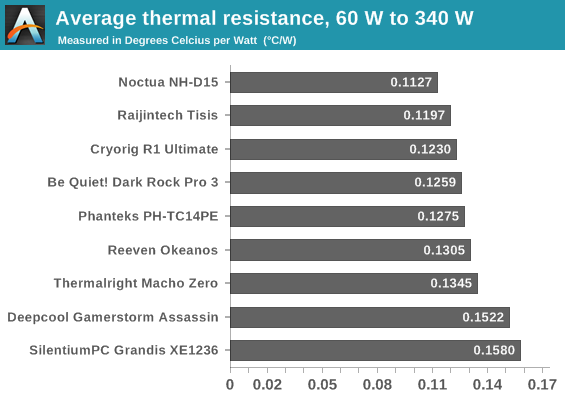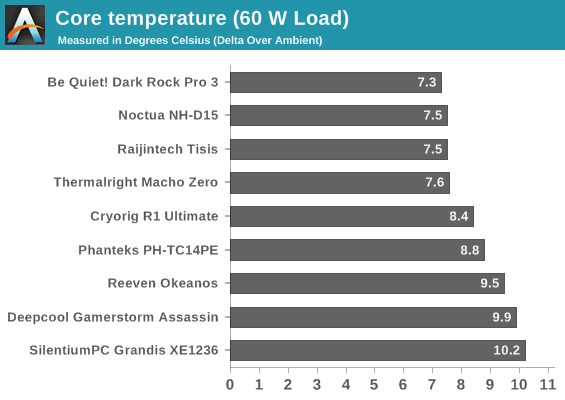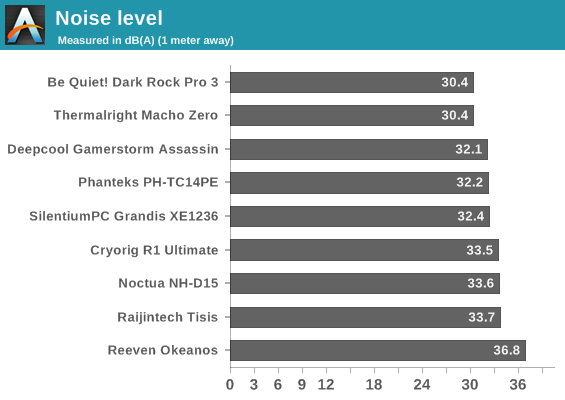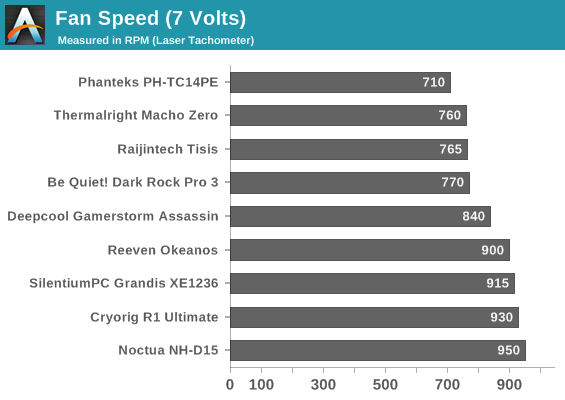Top Tier CPU Air Coolers Q3 2015: 9-Way Roundup Review
by E. Fylladitakis on July 6, 2015 8:00 AM ESTTesting results, low fan speed (7 Volts)


| Core Temperature, Constant Thermal Load |
|
|


*Note: When the cooler has two different fans, the fan speed of the faster fan is recorded.
**Note: Some of this review's PWM fans will not start if simply powered from a 7 Volts power source. Electronic supervision is required to start the fan and then reduce the voltage down to 7 Volts, or a PWM source.
Reducing the fan voltage down to 7 Volts shifts the thermal performance charts a little but brings all of the coolers down to virtually inaudible levels. The sole exception is the Okeanos, which definitely improved vastly in comparison to having its fans running at maximum speed, but remains audible.
With the Okeanos losing its advantage of brute force, the Noctua NH-D15 and the Raijintek Tisis now lead the thermal performance charts, closely followed by Cryorig's R1 Ultimate. The Phanteks PH-TC14PE is a bit more complicated, displaying that it can do much better at lower loads than with high loads, hinting that the airflow of the fans is simply not enough for this design to cope with very high loads. Be Quiet!'s Dark Rock Pro 3 is now showing thermal performance comparable to that of the aforementioned coolers, especially when the thermal load is low. Still, the Dark Rock Pro 3 technically loses its acoustics performance advantage. It may be dead-silent, with our equipment unable to record anything about the room's noise floor level, but the rest of the coolers are virtually inaudible as well.
The Thermalright Macho Zero is at advantage in these tests, as the cooler is optimized for low airflow situations. With the TY147A at a dead-quiet operating level, the Macho Zero offers very good thermal performance, especially at lower loads.
The two coolers with the worst overall thermal performance at this test were the Deepcool Assassin and the SilentiumPC Grandis. As far as the Grandis is concerned, the company will definitely not worry about their product not being able to compete directly with the best air coolers available, as it can still offer very good performance for the price of the cooler. The Assassin on the other hand fails to compete as well as it should, falling behind all other similarly sized products and even behind the Grandis during most of these tests.










135 Comments
View All Comments
TheJian - Tuesday, July 7, 2015 - link
http://www.anandtech.com/show/6830/cpu-air-cooler-...It is far more impressive than you give it credit for. I easily hit >5ghz on this fan with i4790K.
Shadow7037932 - Tuesday, July 7, 2015 - link
If you're going to extreme OCing, why the hell aren't you on custom water cooling or Dice/LN2?Nfarce - Wednesday, July 8, 2015 - link
Because where I am in overclock, the best air keeps up with the best closed loop kit cooling for far less money.tabascosauz - Monday, July 6, 2015 - link
What farce said is true. At high voltages and overclocks, the 212 EVO breaks down and the dual towers begin to shine.DanNeely - Monday, July 6, 2015 - link
Which with simulated thermal loads ranging from 60-340W should have been made apparent in the course of testing.I would hope and expect that most if not all of these coolers would out perform it, especially at higher loads. But as a de-facto standard budget cooler for people who want something better than Intel's I think it should've been added to the matrix to show how much better these bigger ones performed. A stock Intel cooler should've been included as well for the same purposes (at least at the lower loads; no sense risking burning the test setup by trying to broil 340W through it). Including a mainstream reference point is especially important in this case because E. Fylladitakis's synthetic test load means that we can't cross reference his results with those found elsewhere.
SUpstone - Thursday, October 29, 2015 - link
Totally agree - to get the full picture and to aid comparability with other tests the reference points of the Intel stock cooler (free) and CM 212 EVO (£25) should be included.Flunk - Monday, July 6, 2015 - link
If you buy one of those things on sale I've seen them as low as $30, which if you don't need better cooling, is a good deal. The reason the Hyper 212 EVO is popular is that it's cheaper than most of it's competition and easily available. They're good enough for moderate overclocking on a 1150-series chip so they do fit the bill for a lot of people. Something being popular doesn't make it bad.Pastuch - Monday, July 6, 2015 - link
I have 2 of the original Hyper 212 (Non-evo) on two different I5-2500Ks that have been running super quiet at 4.4ghz for the last 4+ years. No coil whine or bearing degradation on the fans. I paid $20 for each Hyper 212 Evo. The value for the money is amazing. It's an excellent quality reliable product and it's easy to install.I paid $220 for my I5-2500k, 20$ for the Hyper 212 Evo, and $70 for 8gbs of PC 1333 in February of 2011. At 4.4ghz, it's still within 5% as fast as any CPU on the market. Sandy Bridge FOREVER! I'll keep buying video cards. You can waste your money on HSF upgrades for CPUs that become less important every day. DX12 is just going to make the CPU even less useful.
Pastuch - Monday, July 6, 2015 - link
Just to clarify, those are Canadian prices which makes them even more amazing. The new I5-K in Canada is almost $300! No thanks.northward - Monday, July 6, 2015 - link
Remember, the average exchange in 2011 was 1.011 (CAD to USD). It is presently 0.79 (CAD to USD). Assuming US/CAN price parity in 2011, that $220 cooler would cost ~$278, not that far behind the $284 i5 4690K.